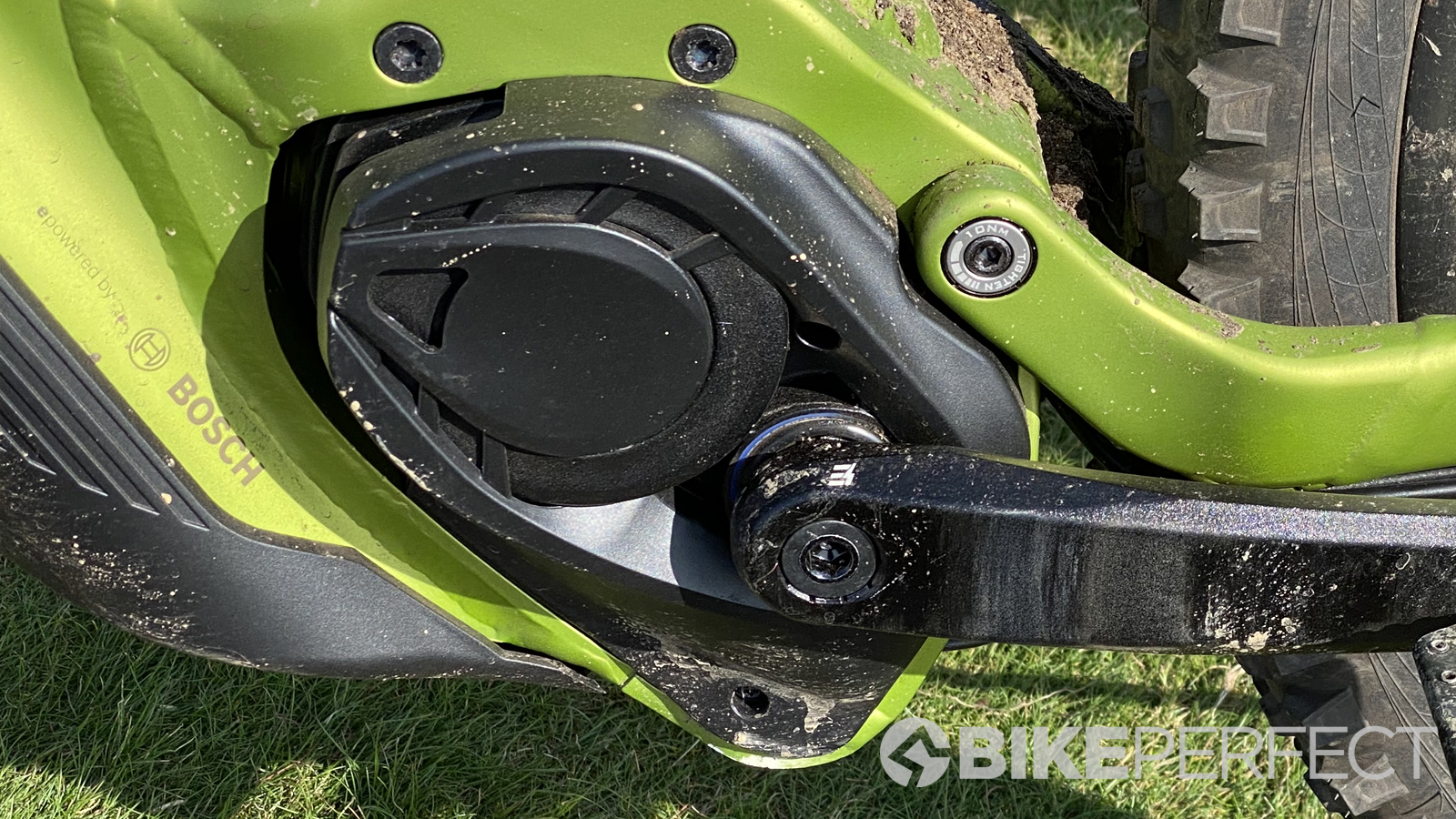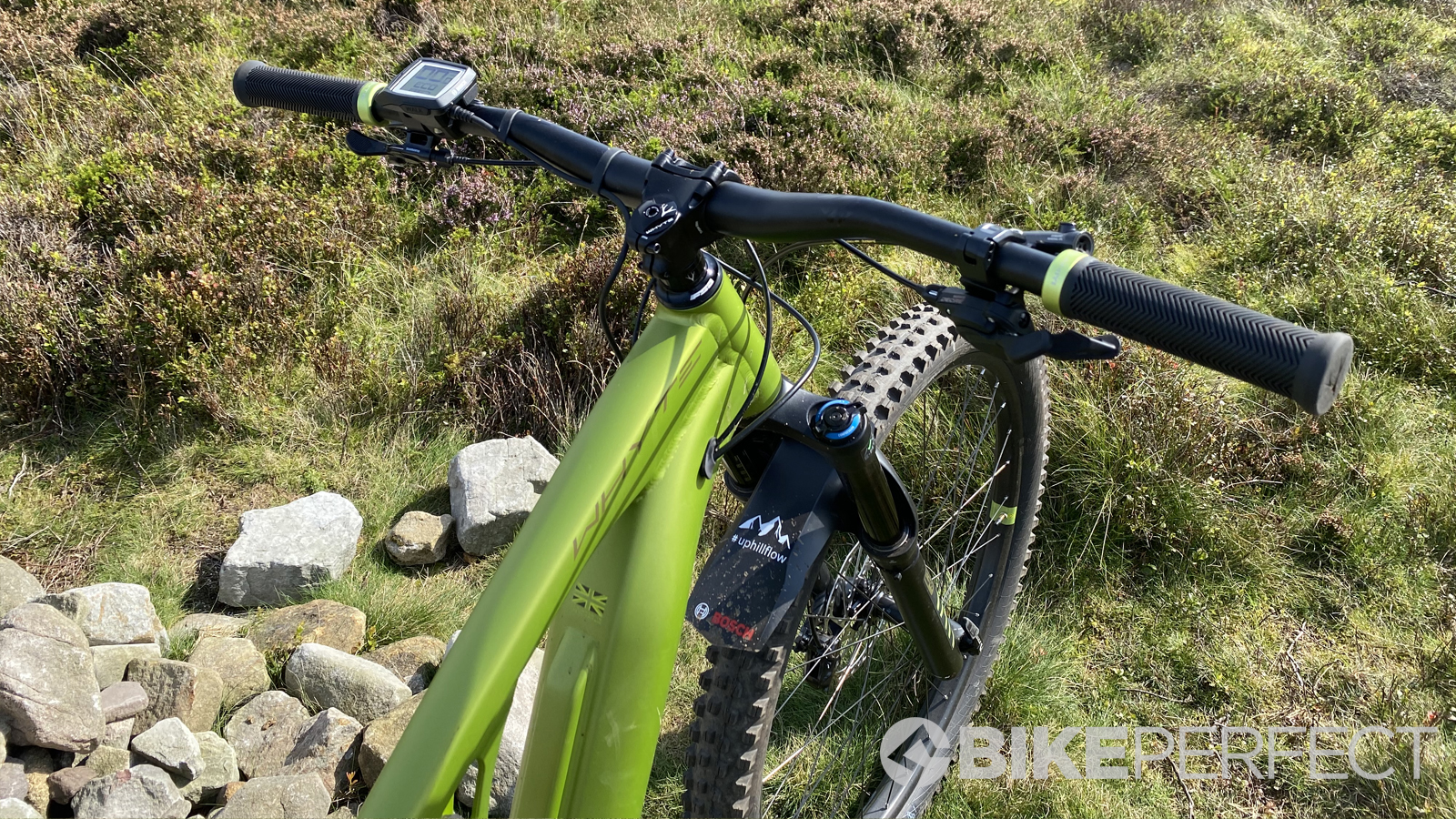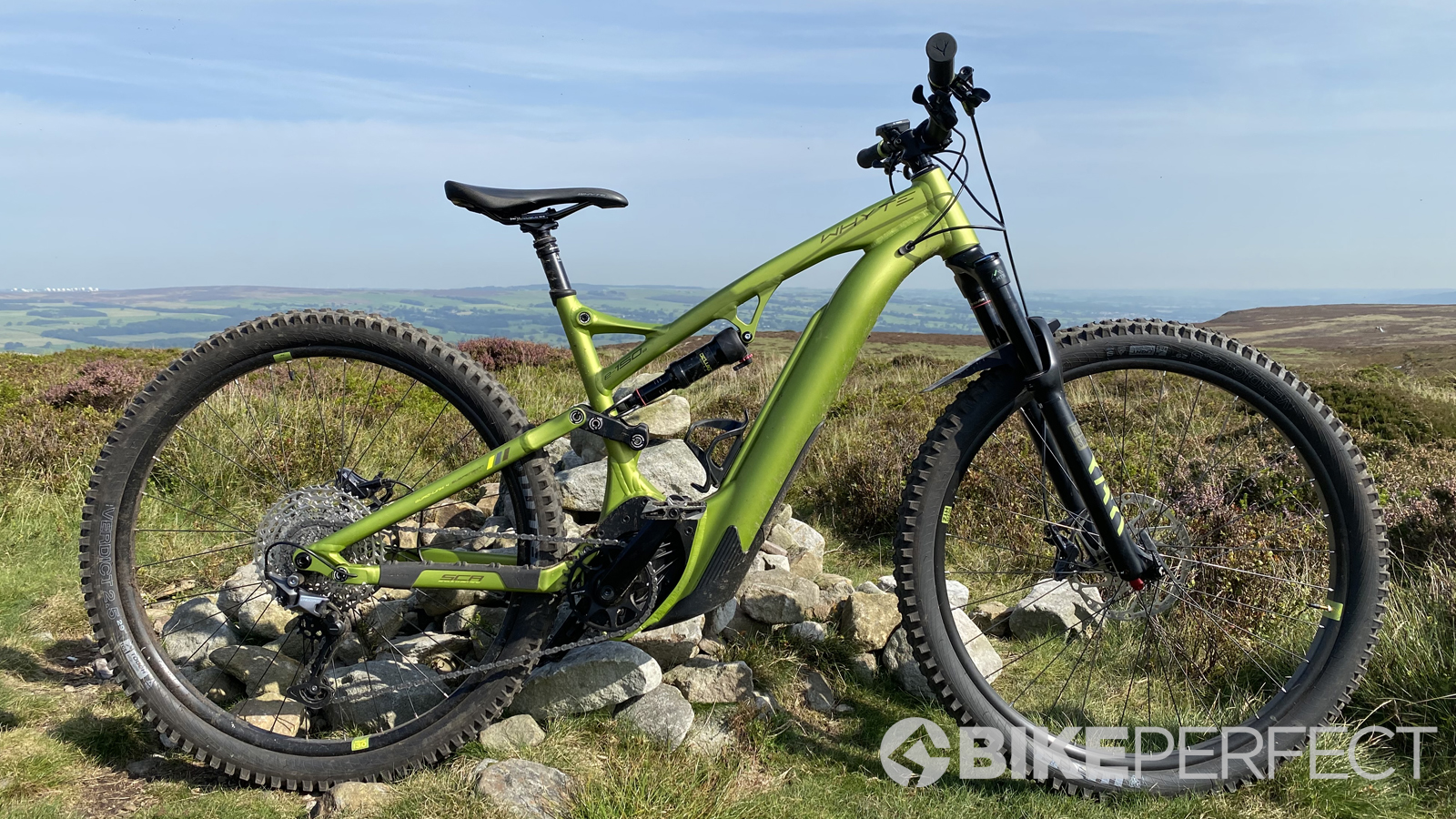Bike Perfect Verdict
The E-150 is a very complete, well-priced, pedal efficient, Bosch-boosted trail-taming e-bike with outstanding handling that makes it an absolute riot to get dynamic on
Pros
- +
Outstanding handling balance
- +
Super low COG stability
- +
Excellent responsiveness
- +
Bosch overdrive
- +
Sensitive yet efficient suspension
- +
Excellent wheel/tire spec
- +
Shimano stop/go reliability
- +
Lifetime bearing warranty
- +
Well-priced
Cons
- -
Seat angle could be steeper
- -
Brakes get pushed to the limit
- -
Fork damper struggles at times
- -
Awkward to remove the battery
Why trust BikePerfect
Whyte Bikes offers only a small range of e-MTBs, but it's evident that the brand has gone for quality over quantity. Bike Perfect has been hitting the trails on the E-150 S and we think this could be one of the best e-MTBs thanks to its well-rounded spec and confident characteristics.
Design and Geometry
The mainframe is closely based on the previous E-150, but it’s still a radical chassis. Rather than an open trough, the down tube is fully enclosed, which makes it extremely stiff. That also means the 625Wh battery slides right down in front of the cunningly rotated Bosch Performance CX G4 motor, so the weight sits super low in the frame. Thankfully, the external sensor wires now exit behind the motor rather than looping out precariously underneath as they did on last year's frame. You do still need to unbolt the motor protection plate to slide the battery out, which is a pain if you don’t have a recharge point where you store the bike. If you do, the charge point sits well protected on top of the motor, and it’s generally a very user-friendly and practical bike. An internal clamp means the seat post can be sealed with a rubber gaiter, and all the suspension bearings have a lifetime warranty. The chainstays, down tube and belly have rubber armoring, and there’s room on the down tube spine for conventional water bottle placement. There’s also plenty of clearance room around the aggressive tread of the Verdict 2.5-inch tires.
While they look essentially identical, the chainstay is slightly longer than the previous model, at 446mm rather than 442mm, to handle the 29-inch rear wheel. The chainstay pivot has also been dropped slightly to increase anti-squat and give the bike more bite and feedback under power. The whole bike also sits slightly higher, although the 335mm bottom bracket is still pretty slammed considering the amount of travel. Reach is well balanced at 476mm, with a 64.7-degree head angle and seat angles from 74.9 to 74.5-degrees depending on size. Proportional balance means you only get the option of M, L or XL sizes with the 29er, but the 150mm, 27.5-inch E-160 model comes in S and XS sizes.

Components
The S model is the more affordable of the two E-150 bikes and is based around the latest 12-speed Shimano Deore kit, featuring super neat EV bar clamps for the shifter and dropper remote. The hubs also come from Shimano, which is always a big win on high-mileage bikes, and 32 single gauge DT Swiss Champion spokes lace into heavy-duty WTB HTZ 30mm e-bike rims. While a lot of mid-travel 29er e-MTBs come with XC style tires to eke out battery range, Whyte isn’t messing around with compromised control, so you get fang tread WTB Verdict 2.5-inch tires, with a High Grip Slashguard version on the front and a Fast Rolling reinforced Enduro version in the back.
The suspension features a short offset RockShox Yari RC fork with 150mm of travel and a RockShox Deluxe Select+ RT rear shock controlling the 140mm of rear travel. Whyte provides the 780mm wide bar, super short 35mm stem and saddle contact points. Whyte has a history of really delivering the goods with out-of-the-box seat post spec, and even by their high standards, they’ve properly aced it this year. The Whyte Drop.it Adjust post is very similar to the PNW Rainier we’ve seen and raved about before and lets you adjust seat post-stroke by 30mm with a simple undo of the collar and shift of a stepped plastic sleeve. Medium and large bikes get 140-170mm of adjust, while XL bikes get a whopping 170-200mm of stroke to play with.

Ride, handling and performance
In addition to a great component list, Whyte has also totally dialed the ride of the E-150 with a distinctively responsive yet stable character. The most obvious aspect of that is the super low center of gravity for an e-bike. While the bike rides slightly higher than it was last year, the way the battery hangs down level with the motor puts the dynamic center of the bike as low as possible. Together with the generous reach, a stable feel is really obvious when carving turns at high speed or when the tires suddenly slip on greasy roots. The short offset fork, super-short stem, seriously stiff mainframe, relatively short rear end, and the ability to get the seat super-low also give the bike a real lightness of touch and instinctive agility for pushing the already very aggressive traction limits right to the ripping edge. That makes the Whyte a bike that you naturally push and place through your feet like a surfer, rather than wrestling with the bars to control top-heavy, high siding habits.
While the natural agility and playfulness could be mistaken for a smaller rear wheel mullet set up, the way the E-150 cuts traction into softer surfaces is definitely still reminiscent of a 29er in terms of performance.
The only slight geometry glitch is a relatively slack seat tube, which means you have to shift your weight forwards onto the saddle nose to get steep slope climbing poise. It’s not a big ask, but it’s something we’ve got out of the habit of doing on the latest bikes with steeper seat angles. Otherwise, technical climbing performance is really helped by the deliberate overrun of the latest Bosch motor, which gives almost a full wheel rotation of power from just a partial crank turn. This is perfect for climbing up steps or ledges on more trials-type sections that the low BB would otherwise potentially create pedal clearance issues on.
Although it’s easy to think that pedaling manners don’t matter as much on an e-bike, the Whyte definitely benefits from a suspension kinematic design that rides efficiently. The firm feeling is certainly a psychological and physical boost when you’re running in lower outputs or charging out of corners on descents. It also lets Whyte open up the compression circuits on the shock with a really light tune, so the back end stays really sensitive and supple for grabbing traction. It means there’s no choke or slam either, and we didn’t realize the 150 namesakes only applied to the fork travel, not the rear end, until Whyte 'fessed up. The 140mm of rear travel actually rides like a bike with more travel. In fact, the most positive thing we can probably say about the rear end is that we never gave it much thought at all after setting baseline sag, as it just did everything we wanted really well and really predictably.
With a bike that encourages and enables you to take serious speed into technical sections, there are moments when the simpler Motion Control RC damper in the Yari fork gets overwhelmed and slightly erratic. Most of the time it’s impressively composed, with the accurate tracking of the 35mm legs making the most of the aggressive tire, cockpit, frame stiffness and geometry choices. If you regularly outrun the damper, you can always drop in a Charger damper from a RockShox Lyrik, but if you’re thinking that way already then just getting the RS model probably makes more sense. That also bags you SRAM X01 Eagle and Double Down casing versions of the legendarily Maxxis Assegai and Minion DHR tires. It also gives you more powerful SRAM Code brakes, replacing the Deore 4 piston brakes, which do a consistently decent job but definitely feel and smell like they are getting close to their limit at times.

Verdict
We’d say defining the limits of how much fun a mid-travel bike lets you have by the smell of cooked brakes and outrunning the damping of a decent enduro fork is a pretty good sign. It’s certainly a tribute to how well dialled the handling, suspension and frame dynamics of the E-150 S are. However, it doesn’t reference the fact that the center of gravity and entertainment-enabling agility of the Whyte means that you’re likely to leave the brakes alone and the front wheel off the floor a lot more than normal. Add more overall power and crucial kick from the uprated Bosch motor, a full-size battery in a bike that handles like it’s got half-size cells, and excellent spec details like the adjustable post and high grip, and you get a very complete, well priced, efficient e-bike that is an absolute riot to ride.
Testing Conditions
- Temperature: 10-15 degrees celsius
- Surface: Man-made red/black flow trails, moorland singletrack and old school natural descents.
Tech specs: Whyte E-150 S
- Model name: Whyte E-150 S
- Discipline: Trail/All Mountain/Enduro
- Price: £4,999
- Head angle: 64.7 degrees
- Frame material: 6061 T6 hydroformed alloy
- Sizes: S, M, L (tested), XL
- Weight: 25.3kg
- Wheel size: 29x2.5in
- Suspension (front/rear): RockShox Yari RC 150mm travel, 42mm offset/RockShox Deluxe Select + RT 140mm travel.
- Components: Bosch Performance Line CX Gen 4, Bosch Powertube 625Wh battery and Purion head unit. Shimano Deore rear mech, shifter, chain and cassette 10-51T. Whyte e-bike crank with SRAM X-Sync2 34T chainring. Shimano Deore BR6000 4 pot brakes with 203mm rotors. WTB Verdict TCS Light/High Grip, Tri-Tec triple compound 29 x 2.5in front tire and Tough/Fast Rolling, Tri-Tec triple compound 29 x 2.5in rear tire on WTB HTZ i30 TCS 2.0 Super Tough Construction rims with 32 DT Swiss Champion 2.0mm single gauge spokes and Shimano MT410 hubs. Whyte 780mm bar and 35mm stem, Whyte drop.it II Adjust 140-170mm stroke dropper post, Whyte saddle.

Guy Kesteven has been working on Bike Perfect since its launch in 2019. He started writing and testing for bike mags in 1996. Since then he’s written several million words about several thousand test bikes and a ridiculous amount of riding gear. He’s also penned a handful of bike-related books and he reviews MTBs over on YouTube.
Current rides: Cervelo ZFS-5, Specialized Chisel, custom Nicolai enduro tandem, Landescape/Swallow custom gravel tandem
Height: 180cm
Weight: 69kg

